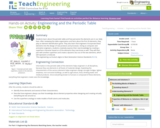
43 Results


Here you can find some great information about the 9th element in the periodic table, "fluorine." Content focuses on fluorine's electrons, where you can find fluorine in nature and in the home, and how fluorine combines with other elements.

Here you can find some great information about the 12th element in the periodic table, "magnesium." Content focuses on magnesium's electrons, where you can find magnesium in nature and in the home, and how magnesium combines with other elements.

Here you can find some great information about the 10th element in the periodic table, "neon." Content focuses on neon's electrons, where you can find neon in nature and in the home, and how neon combines with other elements.

Here you can find some great information about the 7th element in the periodic table, "nitrogen." Content focuses on nitrogen's electrons, where you can find nitrogen in nature and in the home, and how nitrogen combines with other elements.

Here you can find some great information about the 15th element in the periodic table, "phosphorus." Content focuses on phosphorus' electrons, where you can find phosphorus in nature and in the home, and how phosphorus combines with other elements.

Here you can find some great information about the 14th element in the periodic table, "silicon." Content focuses on silicon's electrons, where you can find silicon in nature and in the home, and how silicon combines with other elements.

This collection of publications about genetics includes a unique approach to illustrate a genetics timeline. Important genetic events are correlated with other historical events. The book format allows you to scroll through history.

Students learn about the periodic table and how pervasive the elements are in our daily lives. After reviewing the table organization and facts about the first 20 elements, they play an element identification game. They also learn that engineers incorporate these elements into the design of new products and processes. Acting as computer and animation engineers, students creatively express their new knowledge by creating a superhero character based on of the elements they now know so well. They will then pair with another superhero and create a dynamic duo out of the two elements, which will represent a molecule.
- Subject:
- Chemistry
- Engineering
- Science
- Material Type:
- Activity/Lab
- Provider:
- TeachEngineering
- Provider Set:
- TeachEngineering
- Date Added:
- 10/14/2015

Site highlights the various features of an animal cell. Presents users with a colorful diagram depicting the anatomy of the animal cell. Provides links to obtain more detailed information about the various components found in animal cells.
- Subject:
- Science
- Material Type:
- Reading
- Provider:
- Florida State University
- Date Added:
- 12/01/2023

This site features a clear picture of the plant cell with a concise explanation of its key parts and their functions.
- Subject:
- Science
- Material Type:
- Reading
- Provider:
- Florida State University
- Date Added:
- 12/01/2023

This site from the General Chemistry Online of the Frostburg State University provides a review of the history of atomic theory, the discovery of the electron, and the discovery of the nucleus. Details on weighing atoms, ion charges, isotopes, and counting particles.
- Subject:
- Science
- Material Type:
- Lesson Plan
- Date Added:
- 08/07/2023

This animation from NOVA: "Battle in the War on Cancer: Breast Cancer" describes how oncogenes cause cancer and how cancerous cells can spread throughout the body.
- Subject:
- Science
- Material Type:
- Lesson
- Provider:
- PBS LearningMedia
- Date Added:
- 11/06/2023

Discover the structure and function of the nucleus of the cell.
A free CK-12 account is required to view all materials.
- Subject:
- Mathematics
- Science
- Material Type:
- Lesson
- Provider:
- CK-12 Foundation
- Provider Set:
- CK-12 Life Science
- Date Added:
- 10/02/2022

Discover the organelles of a cell, and how their structure contributes to the cell's function.
A free CK-12 account is required to view all materials.
- Subject:
- Mathematics
- Science
- Material Type:
- Lesson
- Provider:
- CK-12 Foundation
- Provider Set:
- CK-12 Life Science
- Date Added:
- 10/02/2022

Use this site for lots of different ideas on how to make a model of a neuron.
- Subject:
- Science
- Material Type:
- Lesson
- Provider:
- University of Washington
- Date Added:
- 08/07/2023

Discover how mitochondrial DNA (mtDNA) is inherited, and complete a pedigree chart by determining which individuals might share mtDNA with an unknown ancestor.
- Subject:
- Mathematics
- Science
- Material Type:
- Lesson Plan
- Provider:
- PBS
- Provider Set:
- NOVA
- Date Added:
- 08/07/2023

Ancient alchemists attempted but failed to turn different substances into gold. It turns out that the only way to turn one element into another element is using nuclear chemistry! Nuclear reactions change the composition of an atom's nucleus, and this process is useful for many applications.
Khan Academy learning modules include a Community space where users can ask questions and seek help from community members. Educators should consult with their Technology administrators to determine the use of Khan Academy learning modules in their classroom. Please review materials from external sites before sharing with students.
- Subject:
- Chemistry
- Science
- Material Type:
- Lesson
- Provider:
- Khan Academy
- Provider Set:
- Khan Academy
- Date Added:
- 11/17/2020

Explore the form and function of three of the most important cell parts -- the nucleus, cytoplasm, and membrane -- in this video segment adapted from Carolina Biological Supply's "An Introduction to the Living Cell". [3:47]
- Subject:
- Science
- Material Type:
- Audio/Video
- Provider:
- PBS LearningMedia
- Date Added:
- 11/06/2023